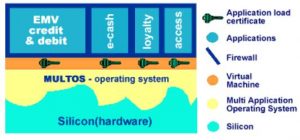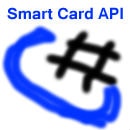Smart Card Operating System
Every smart card has an operating system (OS). The OS is the hardware-specific firmware that provides basic functionality as secure access to on-card storage, authentication and encryption. Only a few cards allow writing programs that are loaded onto the smart card – just like programs on a computer. This is a great way to extend the basic functionality of the smart card OS.
Multi Application Card Operating Systems (MACOS)
Until the emergence of multi-application smart cards, each software application representing a product or service on a card was written for a specific operating system, which in turn was specific to a particular hardware (chip) or silicon platform supplier. Now, multi-application operating systems allow the development of multiple applications that run on one card. On-card applications can’t interfere, they are protected by firewalls.
Currently, the most notable operating systems on the market are:
MULTOS Card Operating System
MULTOS is the first, open, high security, multi-application operating system for smart cards. MULTOS allows you to dynamically load, update, or delete any application during the life of the card.

MULTOS is ideal for on-card application development of programs that need to run inside the secure environment of the smart card chip. Chip enablement, issuance, application load and data load are under control of a certificate based public/private key infrastructure (PKI).
What is a Card Operating System ?
A chip card’s smart card operating system (COS) is a sequence of instructions permanently embedded in the ROM of the smart card. COS instructions are are frequently used by on-card processes and applications. They provide functions for data and command exchange, data storage, data processing, cryptographic processes and more. ,The combination of card OS and all code committed to ROM is often referred to as the ROM “Mask” of an integrated smart card security chip.
General Purpose Card Operating System
The general purpose smart card operating system has a generic command set in which the various sequences cover most applications
Dedicated Card Operating System
A dedicated smart card OS has commands designed for specific applications and can contain the application itself. An example would be a card designed to specifically support an electronic purse, debit or credit application.
Card OS Baseline Functions
The following baseline functions of the smart card OS are common across all smart card products:
- Management of interchanges between cards and the outside world, primarily in terms of interchange protocol.
- Management of the files and data held in memory.
- Access control to information and functions (e.g. select file, read, write, and update data).
- Management of card security and the cryptographic algorithm procedures.Maintaining reliability, particularly in terms of data integrity.
- Management of various phases of the card’s life cycle (e.g. microchip fabrication, personalization, active life, and end of life).
Generally, a card issuer must commit to an operating system, chip manufacturer and applications. This leaves little flexibility to change any of these components without expensive new software and/or hardware implementation.
Early smart cards were costly and inflexible. Nowadays multi-application cards such as JavaCard or MULTOS are very popular.
- Easy-to-use chip card integration with .NET library
with C# and VB.NET sample code for Mifare, DESFire EV1, JavaCard, KVK, eGK, SIM, PIV, CAC, HID Prox, iCLASS, SEOS and many more

